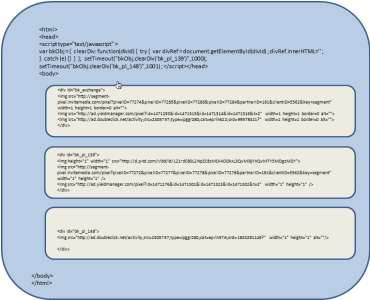Using tags
You can use Oracle Data Cloud platform tags to extract user attributes from your containers (also known as sites, mobile sites, and mobile apps) and to traffic third-party pixels.
This document summarizes and illustrates the tags used for the partner interface (partner.bluekai.com) and tag management service (publisher.bluekai.com).
Note: Oracle Data Cloud tags and code include references to BlueKai and bk. These references are the result of legacy naming policies.
You use the tag management service to schedule the firing of third-party tags from the container. Container tags are not set or visible from the tag management service.
The container tag includes JavaScript and HTML code that collects explicitly defined data from a website and then transfers that data to partners by scheduling third-party tags and pixels onto a client's page. It includes settings that determine how the tag is fired and how data collection and transfer is managed. See creating containers for more information on the different firing methods and options for the various container tag types.
To create and schedule tags:
- Create a container.
- Create a tag.
- Set targeting conditions.
- Schedule the tag into the container.
- Monitor the tag and its latency.
Trafficking third-party pixels
You can traffic third-party image pixels in the partner interface. The image pixels must always be content type image and are typically 1x1 ad server pixels. Pixels trafficked using the partner interface are delivered into the exchange div (<div id="bk_exchange">) and they are governed by Oracle Data Cloud Platform User Experience Guard (UXG). The following example demonstrates an image pixel in the partner interface:
http://d.p-td.com/r/dd/id/L21rdC80L2NpZC8zMDI4ODkxL3QvMi9jYXQvMTY5MDgzMTAhttp://ad.yieldmanager.com/pixel?id=1471293&id=1471315&id=1471314&id=1471316&t=2http://ad.doubleclick.net/activity;src=2305757;type=ipggr280;cat=eprin622;ord=$RAND?
Trafficking third-party tags
You can traffic third-party tags using the tag management service in the platform publisher interface. The third-party tags may consist of JavaScript, HTML, or image pixels. Administrators of the publisher interface have the flexibility to schedule the appropriate tags onto a client's website. Tags trafficked using the publisher interface are delivered into individual tag management divs, which are called placements (for example, <div id="bk_pl_139"> and <div id="bk_pl_141">). The tags are governed by the tag management latency and monitoring settings specified by the tag management administrator (for details, see UXG).
The following examples demonstrate the JavaScript, HTML, and image tags that you can traffic in the publisher interface:
- HTML:
<a href="[http://castleton.com]">castleton.com Home Page</a> - Image:
<IMG SRC="http://tag.bluekai.com/site"> height="1"> For pages with SSL: <IMG SRC="https://stags.bluekai.com/site"> height="1"> - JavaScript:
<script src="http://sampleadnetwork.com/slf/run.js"></script>
Container tag output
The following image shows the container tag.
The bk_exchange and bk_pl (placement) divs output by the tag are described as follows:
<div id="bk_exchange">: All third-party image pixels trafficked through partner.bluekai.com fire within thebk_exchangediv. Best practice is to limit pixel firing inside thebk_exchangediv to four per page view. Third-party image pixels trafficked into thebk_exchangediv are governed by UXG.<div id="bk_pl_139">: All third-party tags trafficked through publisher.bluekai.com inside the Oracle Data Cloud iframe will fire within their own tag management placement div. The tags are governed by the tag management latency and monitoring settings specified by the tag management administrator (for details, see UXG).
Third-party tags trafficked through publisher.bluekai.com but outside the Oracle Data Cloud iframe will fire directly onto the client's page. For third-party tags trafficked outside of the iframe, the Default Tag Avg. Latency Limit (ms) and Tag Avg. Latency Limit Override (ms) settings are enforced, but the Max JS-tag execution time (ms)setting is not.
Note: If a tag is suspended, the platform indicates the suspension by replacing the tag with inert code (for example, <span data-tag-id='334' />). This provides an additional visual queue for partners who are monitoring tag firing schedules (for details, see tag report).




